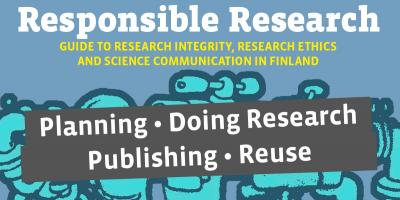A researcher must cite their own earlier work just as conscientiously and honestly as they cite the work of other researchers.
Many researchers may find it perplexing or even frightening that violations of responsible conduct of research also include self-plagiarism. Our thoughts are our own, so why should we not be freely allowed to repeat them, should we wish to do so? The answer is that naturally we may do so, as long as we appropriately cite our own previous publications if we re-use material we presented on an earlier occasion.
Self-plagiarism occurs when a researcher publishes the same findings again but gives readers to understand that these have not previously been published. It is also self-plagiarism if the research is translated into another language without citing the original work. Nor should researchers present original publications and their translations as separate publications in a CV or list of publications.
Violations of responsible conduct of research also include self-plagiarism.
Repeating large chunks of text unchanged should be avoided, or the extract should be shown as a direct quote by adding a reference to one’s own previous publication. Researchers should cite their own earlier work in exactly the same way as they would cite the publications of other researchers.
Presenting previously published data and findings as if they were new can hardly happen by accident. As far as textual content is concerned, however, this kind of accident may well occur if, for example, large amounts of text are cut and pasted from a previous publication as the basis for creating a new one. Self-plagiarism is very easy to avoid by structuring the text of the publication as a new text from the start. We all have our own ways of expressing ourselves but when addressing a specific topic, we do not normally write several sentences in a row, word for word, in exactly the same way every time. As always, the researcher should seek to read a broad amount of material associated with the topic, filter it through their own constantly developing thought processes and produce their own view or synthesis for a publication.
Today’s major pressure to publish increases the risk of unwitting and of deliberate self-plagiarism, as many different publications are often derived from the same project and their content is also made use of in review articles, for example. For this reason, too, publishing findings as larger entities, and aiming for a smaller total number of publications could be a major benefit to us as researchers and to science in general. However, this is obviously a wide-reaching issue that concerns the whole gamut of science, science funding and scientific credit.
There are also situations in science writing where repeating oneself may be a very good thing.
On the other hand, there are also situations in science writing where repeating oneself may be a very good thing. My own discipline is imaging neuroscience, in which developed neurotechnologies and computational methods enable us to carry out non-invasive recording of human brain function when a person is looking at pictures, reading texts or making decisions, for example.
Measuring and analysing brain signals involve many stages which have to be described accurately so that other researchers can understand them and replicate them if necessary. In these kinds of disciplines that rely on advanced technologies, it is extremely important to describe a particular process in as identical a way as possible, using the same terminology every time, and not to invent new expressions merely for the sake of varying the way matters are presented. This enables potential changes in processes compared with previous research to be clear to the reader. When describing methods in this way, reference is, of course, made to previous publications, but it is more sensible to cite one’s own previous research in which the essential content of methods was presented for the first time, rather than some publication in which the wording used to describe the methods might be more similar to that used in this new work. The way the methods are presented in the publications of research groups often develops to become clearer and more succinct a little at a time, and it is difficult to determine which previous publication might have been the most direct source of the way the methods were described.
A researcher can thus freely make use of their earlier research findings and deep thinking but they must cite their own earlier work just as conscientiously and honestly as they cite the work of other researchers.
Riitta Salmelin is a professor in Aalto University’s Department of Neuroscience and Biomedical Engineering and a member of the Finnish National Board on Research Integrity
You might also be interested in
Tämä teos on lisensoitu Creative Commons Nimeä 4.0 Kansainvälinen -lisenssillä. Detta verk är licensierat under en Creative Commons Erkännande 4.0 Licens. This work is licensed under a Creative Commons Attribution 4.0 International license.

